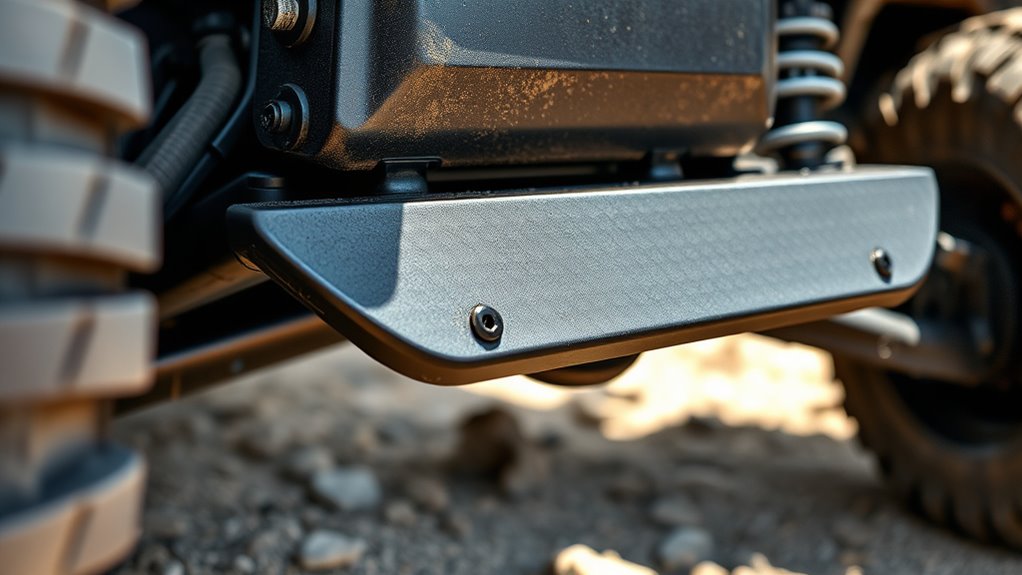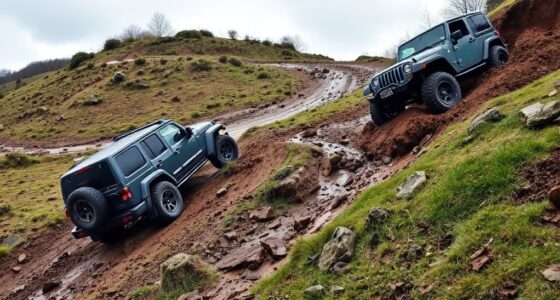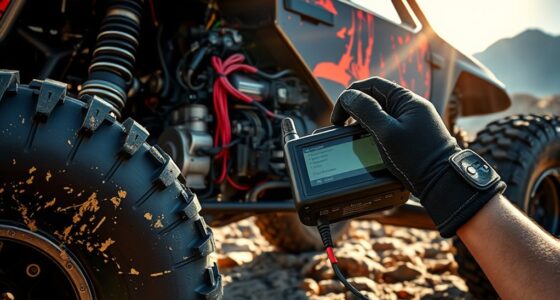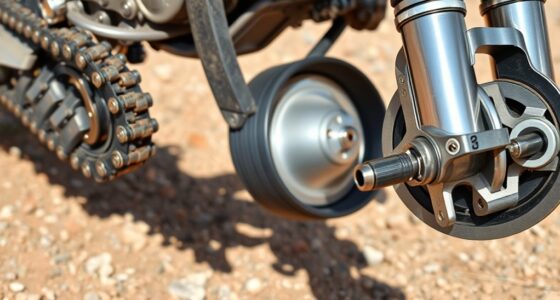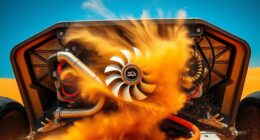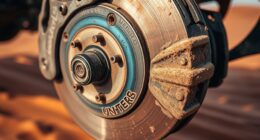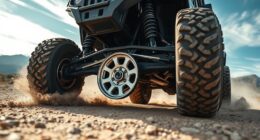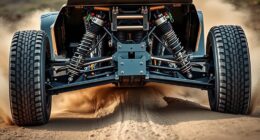Balancing protection with weight is key when choosing skid plates for off-road adventures. Heavier plates like steel offer maximum durability but can slow your vehicle and reduce agility. Lighter options like aluminum or composites help maintain speed and maneuverability but may cost more or wear faster. The best choice depends on your terrain and performance needs. To learn how to find the perfect balance, explore the factors behind material selection and design considerations.
Key Takeaways
- Thicker skid plates offer better impact protection but increase weight, potentially reducing vehicle responsiveness and speed.
- Using lightweight materials like aluminum or composites helps balance protection with minimal weight gain.
- Proper design and material selection optimize impact resistance without compromising agility or acceleration.
- Heavier skid plates can cause sluggish steering and higher suspension strain, affecting off-road handling.
- Matching skid plate material and thickness to terrain conditions ensures safety without sacrificing vehicle performance.
The Role of Skid Plates in Off-Road Safety
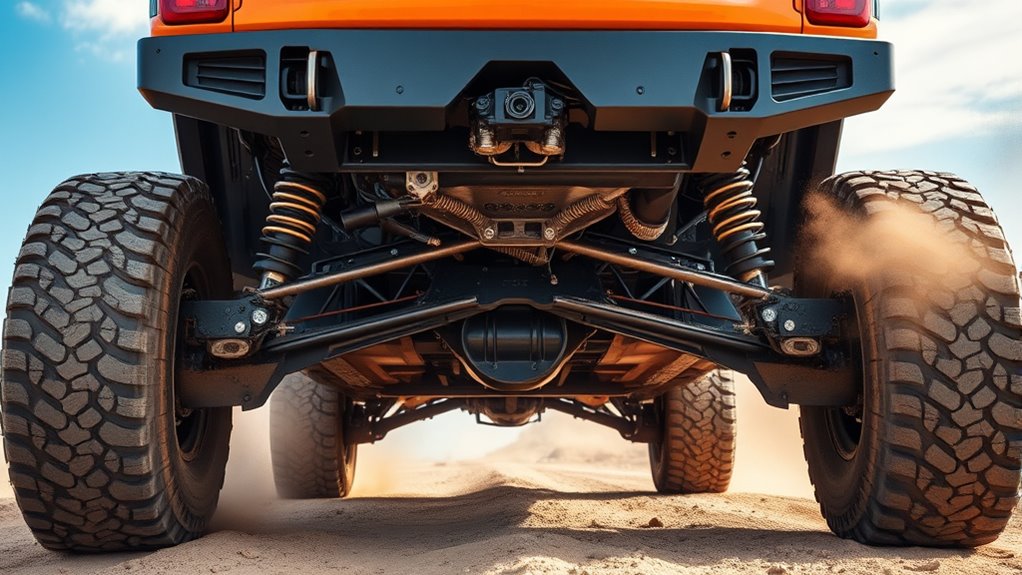
Skid plates play a crucial role in off-road safety by protecting your vehicle’s underside from rocks, roots, and rough terrain. When you’re steering through challenging trails, debris and uneven surfaces can cause significant damage to essential components like the oil pan, transmission, and transfer case. Without skid plates, these parts are exposed, increasing the risk of punctures, dents, or costly repairs. They act as a barrier, absorbing impacts and preventing direct contact with hazardous obstacles. This protection allows you to confidently push through tough sections, knowing your vehicle is safeguarded against hidden dangers below. Additionally, using vertical storage solutions can help organize your gear and reduce clutter, ensuring that your focus remains on navigating difficult terrain safely. Ultimately, skid plates give you peace of mind and help maintain your vehicle’s integrity during demanding off-road adventures.
Materials Used in Skid Plate Construction
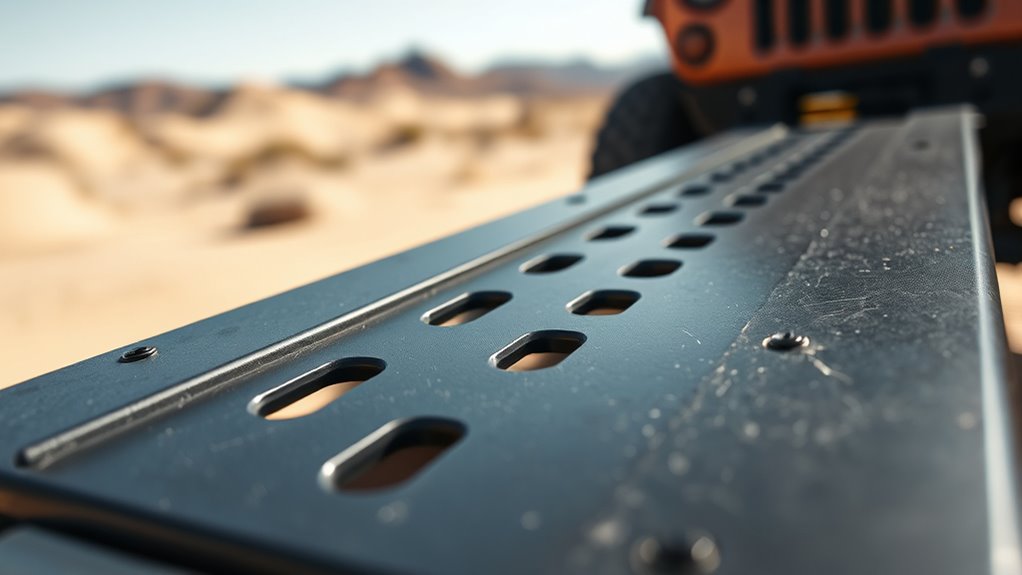
To effectively protect your vehicle’s underside, the materials used in skid plate construction must withstand harsh impacts and resist corrosion. Common choices include steel, aluminum, and composite materials. Steel offers high strength and durability, making it ideal for heavy-duty off-road use, but it’s heavier and prone to rust unless properly coated. Aluminum is lighter and naturally resistant to corrosion, which helps reduce overall weight and improve fuel efficiency, though it’s generally less impact-resistant than steel. Composite materials, such as reinforced plastics or carbon fiber, combine strength with lightweight properties and excellent corrosion resistance, but tend to be more expensive. Your choice depends on your driving conditions, budget, and the balance you want between protection and weight.
How Thickness and Design Affect Weight
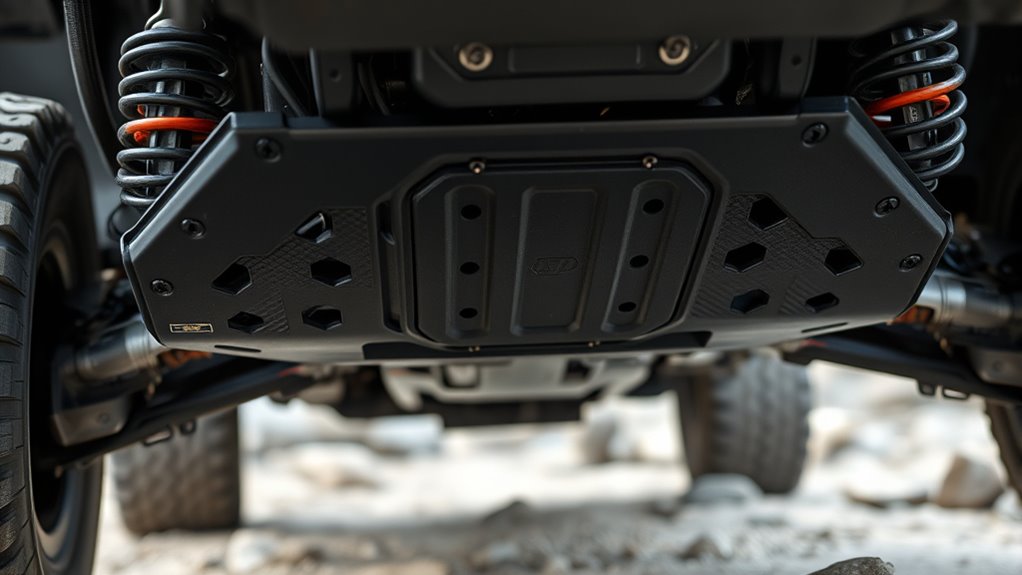
The thickness and design of a skid plate directly influence its weight, impacting both protection and vehicle performance. Thicker plates provide more durability, but they also add significant weight, which can reduce speed and agility. Conversely, thinner plates save weight but may compromise protection against impacts. The design also matters; a complex, reinforced structure generally weighs more than a simple, streamlined one. You need to find a balance where the skid plate offers sufficient protection without unnecessarily weighing down your vehicle. Consider how different thicknesses and designs distribute strength and impact absorption. Optimizing these factors guarantees you maintain a good mix of protection and performance, allowing you to tackle rough terrains without sacrificing speed or fuel efficiency. Additionally, understanding security measures in payment processing can help protect against cyber threats that compromise vehicle systems or data.
Comparing Steel, Aluminum, and Composite Options
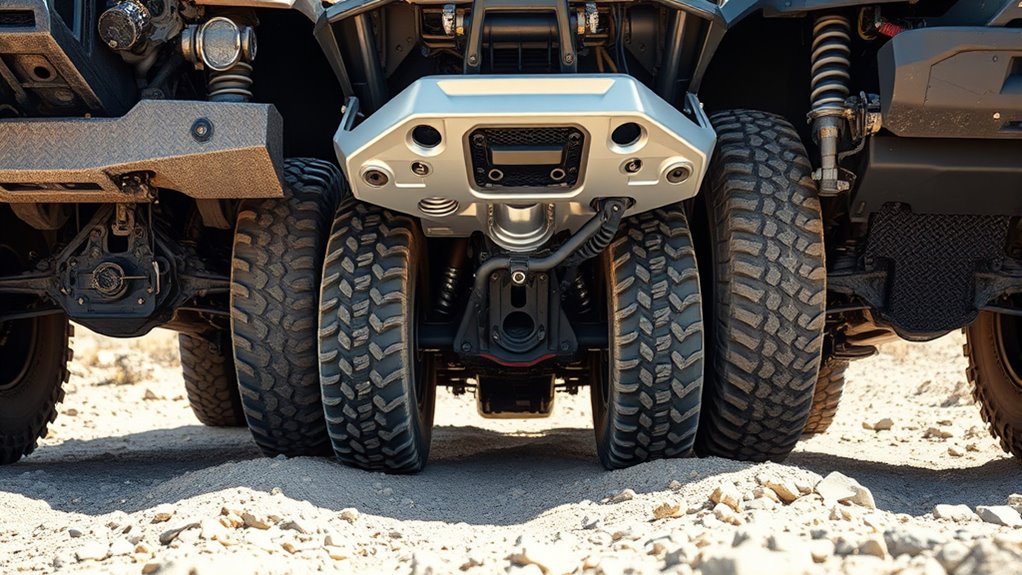
When choosing between steel, aluminum, and composite skid plates, you’ll want to take into account durability and weight to match your driving needs. Steel offers strength but adds weight, while aluminum is lighter but less tough, and composites strike a balance. Additionally, think about the cost and how easy each option is to install, as these factors can impact your overall upgrade. For example, self watering plant pots showcase the importance of material selection to ensure proper function and longevity.
Durability and Weight
Choosing the right skid plate involves balancing durability with weight, as different materials offer distinct advantages and trade-offs. Steel is incredibly tough and long-lasting, providing excellent protection against impacts, but it’s heavy and can add significant weight to your vehicle. Aluminum is lighter yet still durable, offering good impact resistance without sacrificing too much speed or fuel efficiency. Composite materials, like reinforced plastics, excel in reducing weight further while providing decent protection, but they may not withstand repeated heavy impacts as well as metal options. Your choice depends on your needs: if maximum durability is essential, steel is best; if you want to minimize weight without sacrificing too much strength, aluminum or composites could be better options. Additionally, advancements in AI Safety research are contributing to developing smarter, more resilient materials that could influence future skid plate technology.
Cost and Installation
Comparing the cost and installation of steel, aluminum, and composite skid plates reveals significant differences that can influence your decision. Steel plates are generally the most affordable upfront, but they’re heavier and may require more robust mounting hardware, increasing installation complexity and labor costs. Aluminum skid plates are more expensive initially but are lighter, making installation easier and potentially reducing labor costs. Composite plates tend to be the priciest option, but their lightweight design simplifies installation and minimizes modifications. While steel offers durability at a lower price, it may incur higher long-term costs due to added weight. Aluminum strikes a balance between cost and ease of installation, whereas composites provide premium protection with simpler, quicker installation but at a higher price point. Additionally, the material composition influences the overall performance and suitability for different environments.
Impact of Skid Plate Weight on Vehicle Dynamics

The weight of a skid plate directly influences a vehicle’s handling and performance, especially at higher speeds. Heavier skid plates can add significant inertia, making your vehicle less responsive and increasing suspension stress. This can lead to slower steering, reduced agility, and decreased fuel efficiency. Keep in mind:
- Heavier plates may cause more wear on suspension components
- Increased weight can lower acceleration and top speed
- Handling becomes less precise during quick maneuvers
- Higher weight may contribute to increased tire wear
- The contrast ratio of a skid plate material can affect its durability and impact absorption capabilities.
Balancing protection with weight is essential. While a sturdy skid plate shields your vehicle, too much weight can compromise overall dynamics. Choosing the right material and thickness helps optimize performance without sacrificing safety.
Strategies for Optimizing Protection and Performance
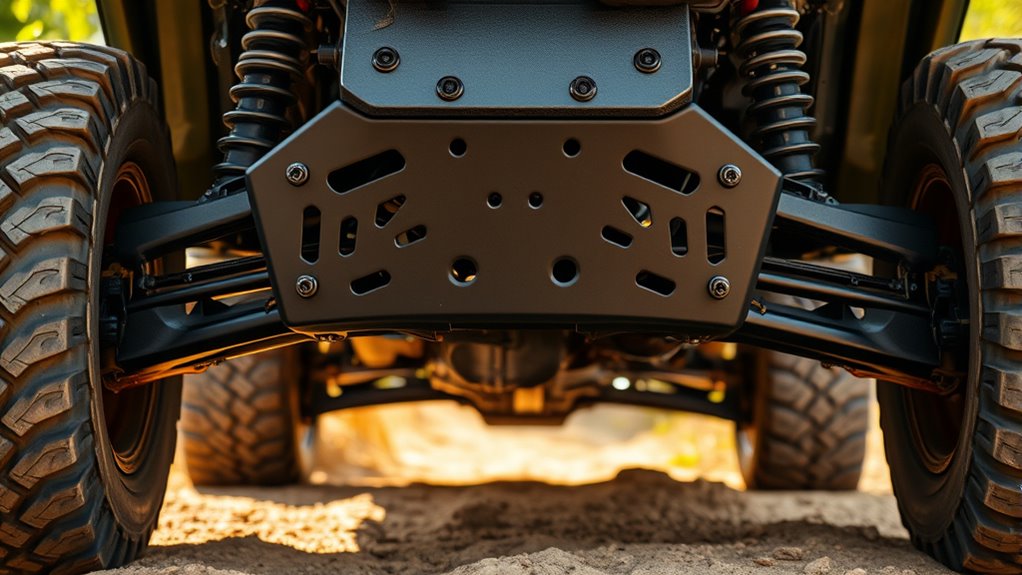
To optimize both protection and performance, focus on selecting materials and designs that strike the right balance between durability and weight. Use lightweight, high-strength materials like aluminum or advanced composites to reduce added mass while maintaining impact resistance. Consider modular or multi-layer designs that provide targeted protection without unnecessary bulk. Incorporize strategic cutouts or venting to decrease weight without sacrificing strength. Guarantee your skid plate’s thickness and shape are tailored to your vehicle’s typical terrain, avoiding over-engineering. Regularly assess your setup based on your driving style and conditions. Incorporating material durability considerations ensures your skid plate can withstand rugged terrain over time. By fine-tuning material choices and design features, you enhance your vehicle’s agility and speed without compromising essential protection. This approach ensures you stay agile and safe on rugged trails.
Making the Right Choice for Your Off-Road Adventures

Choosing the right skid plates depends on balancing material durability and weight to suit your needs. You should consider the terrain you’ll encounter to guarantee compatibility and protection. Finally, weigh the cost against the level of protection you require to make an informed decision. Incorporating good lighting in your setup can also enhance visibility and safety during off-road adventures.
Material Durability and Weight
When selecting skid plates for your off-road adventures, balancing durability and weight is essential to guarantee peak protection without sacrificing performance. Heavier materials often provide better durability but can slow you down and drain your fuel. Lighter options improve agility but may wear faster or crack under heavy impacts. To make the right choice, consider these points:
- Strength-to-weight ratio is critical for optimal protection without added bulk.
- Material resistance to corrosion prolongs skid plate lifespan.
- Impact absorption helps protect vital components during rough terrain.
- Ease of installation influences how quickly you can equip or replace your skid plates.
Choosing a material that offers the right mix of toughness and lightness ensures you’re protected while maintaining speed and maneuverability.
Off-Road Terrain Compatibility
Selecting skid plates that suit your off-road terrain guarantees maximum protection and performance. For rocky trails, opt for thick, plate materials that can withstand sharp edges and heavy impacts. If you’re tackling muddy or sandy terrain, look for lightweight plates that won’t bog you down but still provide sufficient shielding. Snowy or icy conditions require corrosion-resistant coatings to prevent rust and ensure longevity. Consider the terrain’s severity—rough, jagged paths demand robust, full-coverage skid plates, while milder trails may only need partial protection. Also, check for proper clearance to avoid snagging on uneven ground. Matching your skid plate choice to your specific off-road environment guarantees you’re protected without sacrificing agility or speed during your adventures. Incorporating terrain-specific features can further enhance your vehicle’s performance and durability in challenging conditions.
Cost vs. Protection Balance
Balancing cost and protection is key to making the right skid plate investment for your off-road adventures. You want durable protection without breaking the bank or adding unnecessary weight. Consider these points:
- Material quality affects longevity and impact resistance, influencing price.
- Weight impacts vehicle performance and fuel efficiency.
- Installation costs can vary based on complexity and labor.
- Frequency of use determines whether a higher upfront investment pays off.
- Incorporating high-quality materials can enhance impact resistance and durability, ultimately saving money on replacements over time.
Choosing the right balance means evaluating how often you hit rough terrain versus your budget. Cheaper materials may save money upfront but could require replacement sooner. Investing in quality might cost more initially but offers better long-term protection. Evaluate your needs carefully to avoid overspending or skimping on essential protection.
Frequently Asked Questions
How Does Skid Plate Design Influence Vehicle Fuel Efficiency?
You might wonder how skid plate design affects your vehicle’s fuel efficiency. When designed with lightweight materials and streamlined shapes, skid plates can reduce overall weight and drag, helping you save fuel. Conversely, bulky or heavy skid plates add weight and increase air resistance, which can lower efficiency. As a result, choosing an optimized, lightweight skid plate design ensures you’re protected without sacrificing your vehicle’s fuel economy.
Can Aftermarket Skid Plates Void Vehicle Warranty?
Is a warranty a safety net or a ticking time bomb? When you consider aftermarket skid plates, know that installing them might void your vehicle’s warranty, especially if the manufacturer links the parts to damage or modifications. Always check your warranty terms and consult your dealer before adding aftermarket parts. Staying informed helps you protect your investment and avoid unexpected costs down the road.
Are Lightweight Skid Plates as Durable as Heavier Options?
You wonder if lightweight skid plates hold up as well as heavier ones. Generally, lighter skid plates can be just as durable if made from high-quality materials like aluminum or composite, but they may not offer the same level of protection in extreme conditions. It’s important to take into account your driving environment and needs. Choose a well-constructed, reputable brand to guarantee your skid plate provides reliable protection without unnecessary weight.
How Do Skid Plates Affect Vehicle Clearance and Approach Angles?
Did you know that adding skid plates can lower your vehicle’s clearance by up to 1.5 inches? This impacts your approach angles, making steep climbs more challenging. When you install skid plates, they can slightly reduce your ground clearance, which might hinder off-road performance. However, they protect essential components, so you need to balance the trade-off based on your driving needs.
What Maintenance Is Required for Different Skid Plate Materials?
You need to regularly inspect your skid plates for damage, corrosion, or loose bolts, regardless of material. Aluminum skid plates require cleaning and occasional polishing to prevent corrosion, while steel ones might need rust treatment and repainting. Plastic or composite plates should be checked for cracks or warping after off-road use. Always follow manufacturer recommendations for maintenance intervals and procedures to guarantee your skid plates stay effective and durable.
Conclusion
Choosing the right skid plate is like balancing a tightrope—you want solid protection without weighing down your ride. Think of it as fitting armor that guards your vehicle’s essential organs without turning it into a lumbering beast. By understanding materials and design, you can find that sweet spot where safety and speed dance in harmony. So gear up wisely, and let your off-road adventures be fierce, protected, and free to soar like an eagle in the wild.
